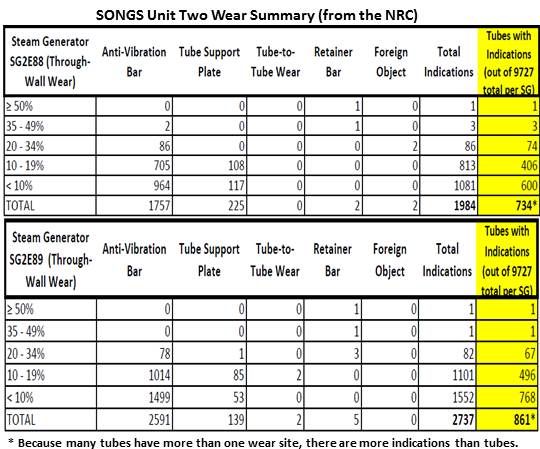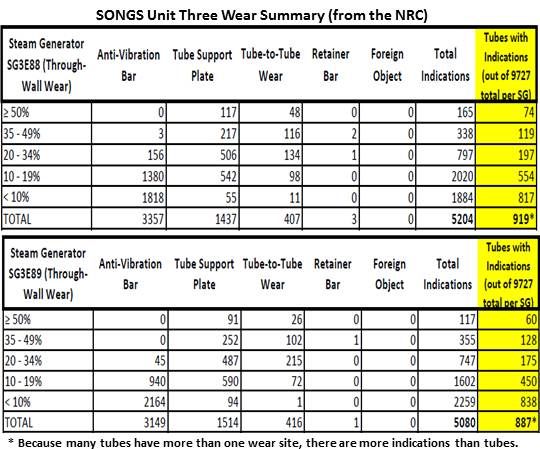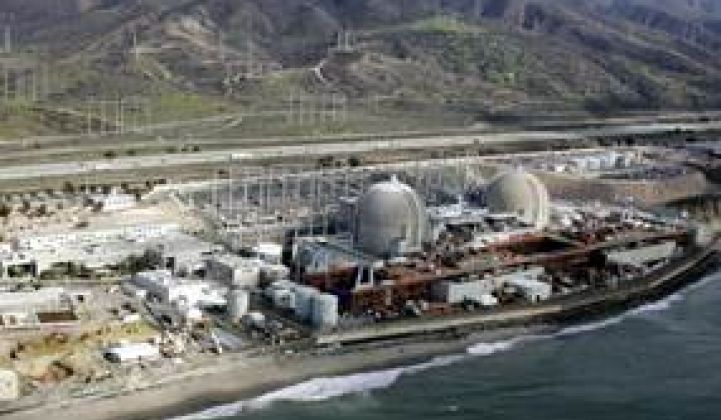California’s transmission system operator is scrambling to meet a load deficit caused by the 2,300-megawatt outage of the San Onofre Nuclear Generating Station (SONGS). The system operator is bringing shuttered natural gas plants on-line, calling for Southern Californians to conserve electricity and warning of the possibility of blackouts.
The two steam generators (2E088 and 2E089) of the 1,172-megawatt Unit Two at the SONGS were replaced in January 2010.
The two steam generators (3E088 and 3E089) of the 1,178-megawatt Unit Three at the SONGS were replaced in January 2011.
Unit Two began a scheduled outage for refueling on January 10, 2012, and was out of service when control room operators shut Unit Three down on January 31, 2012. Both units have been offline ever since. Neither is expected to be ready for service before the end of this summer.
Without recently activated transmission and the other efforts, California Independent System Operator Director of Communications Stephanie McCorkle recently told GTM, the LA Basin would be short 240 megawatts on a high-demand hot day, and the San Diego area would be short 337 megawatts. With them, she said, there are reserve margins of only thirteen megawatts in San Diego and 212 megawatts in the LA Basin.
The SONGS Unit One was first-generation Westinghouse technology. It went on-line in January 1968, and was built to last until 2004 but was decommissioned in 1992 due to wear.
Unit Two went on-line in August 1983, while Unit Three went on-line in April 1984. Both units rely on an old and less efficient technology built by Combustion Engineering (subsequently bought by Westinghouse). The replacement of the steam generators at the SONGS was done by Mitsubishi Heavy Industries.
The steam generators are where the heat generated by the light water reactors turns water into the steam, which drives the facilities’ electricity-generating turbines. This type of turbine can also generate electricity with steam created by water boiled with coal, natural gas, geothermal stations or concentrating solar power stations.
“Think of a steam generator as a large egg filled with water and thousands of long, thin metal tubes in a U-shape formation attached at the bottom of the egg,” wrote Nuclear Regulatory Commission (NRC) Public Affairs spokesperson Lara Uselding in March. “As the hot water travels through the tubes, the rest of the water in the egg becomes steam. The steam is transferred to the turbine.”
Each SONGS steam generator is 65 feet tall and weighs 1.3 million pounds. Each has two large U-shaped tubes which have 9,727 U-shaped, three-quarter-inch-diameter tubes running through them.
The failure of a steam generator tube, Uselding went on, “is a problem, because radioactive water that passed over the nuclear reactor and into the steam generator may escape into the created steam through a hole in the tube. Then, the radioactive steam could end up at the turbine and eventually may escape to the environment.”

To prevent faulty tubes from leaking radioactive steam, plant operators do regular inspections and catalog indications of wear. If a tube is found to be severely worn, it is plugged.
According to the NRC, the “total plugging for Unit 2 was 205 tubes in 2E088, and 305 in 2E089.” There was “extensive plugging and selective staking of 807 tubes in Unit 3 (420 in 3E088 and 387 in 3E089).”

Southern California Edison (SCE), the SONGS operating utility, reported “1,595 tubes showed wear of some type” in Unit Two and, of the 510 tubes plugged, six were plugged because of “wear of more than 35 percent and the rest for preventative measures.” In Unit Three, SCE reported, “1,806 tubes showed wear of some type,” and of the 807 tubes plugged, 381 were plugged “for wear of more than 35 percent and the rest for preventative measures.”

Vermont nuclear watchdog group Fairewinds Associates, at the request of Friends of the Earth, used NRC data to compare “the replacement steam generator plugging at both San Onofre Units Two and Three to the replacement steam generator plugging history for all other replacement steam generators at U.S. nuclear power plants.”
It concluded that the San Onofre reactors “plugged 3.7 times as many steam generator tubes than the combined total of the entire number of plugged replacement steam generator tubes at all the other nuclear power plants in the U.S.”
Fairewinds also evaluated a report by SCE that found that Unit Two is ready to be restarted. Fairewinds concluded, “There is no difference in the failure modes between the two units and both should remain shut down until extensive modifications or fabrication of replacement generators are completed.”



